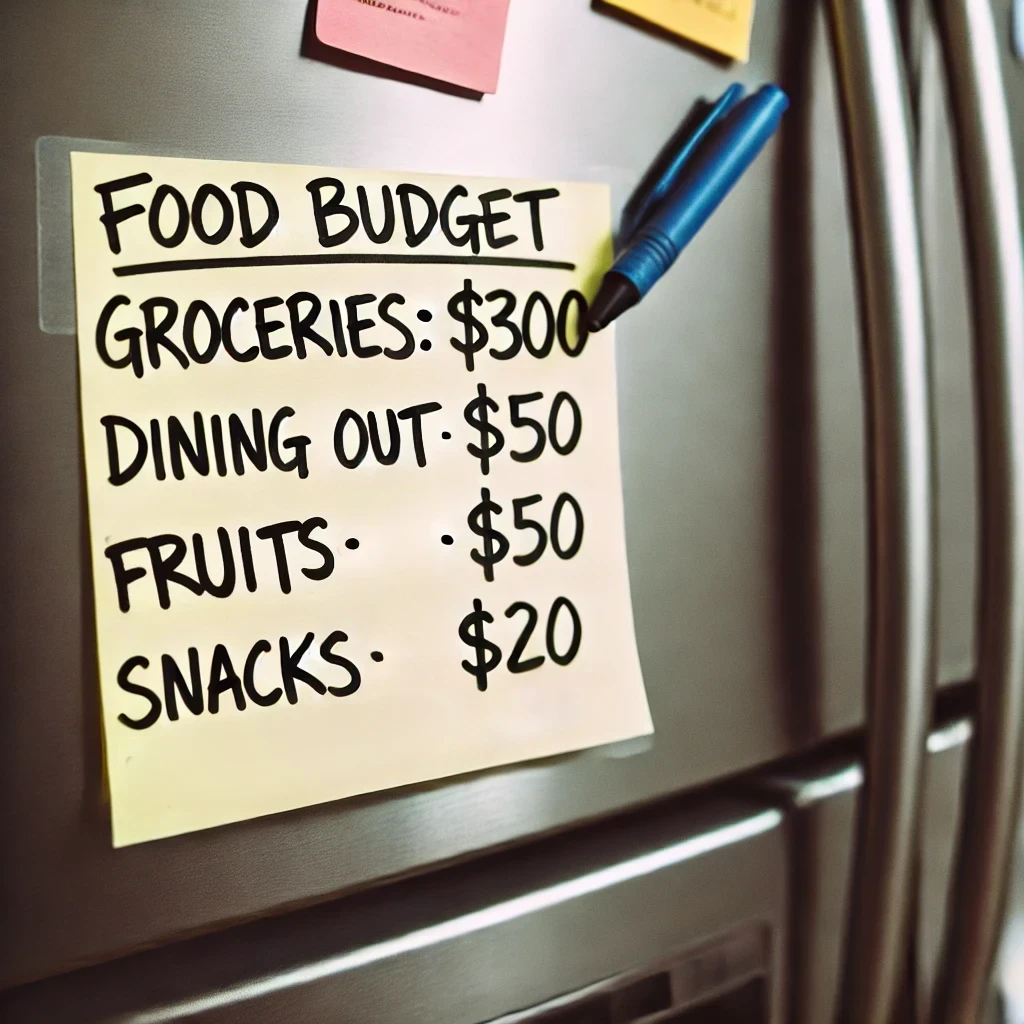Introduction
Mastering the art of food budgeting is essential for maintaining financial stability and promoting healthier eating habits. Effective food budgeting not only helps control spending but also ensures that nutritious meals are always within reach. This comprehensive guide addresses the diverse needs of different household sizes, providing tailored strategies for individuals, couples, and families. Understanding the importance of food budgeting and implementing practical tips can lead to significant savings and improved financial well-being.
Understanding Food Budgeting
What is Food Budgeting?
Food budgeting is the process of planning and managing the amount of money allocated for food expenses over a specific period, typically a month. This involves setting a spending limit based on income, tracking expenses, and making informed decisions about purchasing groceries and other food items. The primary goal is to ensure that money is spent wisely, avoiding overspending while maintaining a healthy and balanced diet.
The relevance of food budgeting in daily life cannot be overstated. It helps in maintaining financial stability by preventing unnecessary expenditures and ensuring that funds are available for other essential needs, such as housing, utilities, and savings. Effective food budgeting encourages mindful spending and promotes better financial habits. By planning meals and shopping lists, it becomes easier to avoid impulse buys and focus on purchasing nutritious and cost-effective ingredients. This practice not only saves money but also supports healthier eating habits, contributing to overall well-being and a more organized lifestyle.
The Importance of Food Budgeting
Why is Food Budgeting Important?
Food budgeting offers numerous benefits that extend beyond mere financial management. One of the primary advantages is the promotion of financial stability. By setting and adhering to a food budget, it becomes easier to control spending, avoid debt, and allocate funds to other essential expenses, such as housing, utilities, and savings. A well-planned food budget helps prevent impulse purchases and minimizes the likelihood of running out of money before the end of the month.
Additionally, food budgeting can lead to healthier eating habits. With a clear budget in place, it is possible to plan meals in advance, focusing on nutritious and cost-effective ingredients. This reduces the temptation to rely on expensive takeout or unhealthy processed foods. Planning meals around a budget encourages the purchase of fresh produce, whole grains, and other nutrient-dense foods that contribute to overall well-being.
Furthermore, food budgeting fosters a sense of mindfulness and discipline in spending. By regularly reviewing and adjusting the budget, it becomes easier to identify and eliminate wasteful habits. This proactive approach not only improves financial health but also instills a greater appreciation for the value of money and resources. Overall, food budgeting is a vital practice that enhances both financial stability and dietary quality, leading to a more balanced and fulfilling lifestyle.
Creating a Monthly Food Budget
Steps to Create an Effective Food Budget
Creating an effective food budget involves a systematic approach to planning and managing food expenses. Here are the steps to help you get started:
- Assess Your Monthly Income:Begin by calculating your total monthly income. Include all sources of income, such as salary, freelance work, and any other earnings.
- Determine Your Food Budget: Allocate a specific percentage of your monthly income to food expenses. A general guideline is to allocate about 10-15% of your income to food, but this can vary based on personal circumstances.
- Track Your Current Spending: Monitor your food expenses for one month to understand your spending habits. Use a notebook, spreadsheet, or budgeting app to record every food purchase, including groceries, dining out, and snacks.
- Categorize Your Expenses: Divide your food expenses into categories such as groceries, dining out, and miscellaneous food items. This helps identify areas where you can cut back or adjust spending.
- Set Realistic Goals: Based on your tracked expenses and income, set realistic spending limits for each category. Ensure your goals are achievable and reflect your lifestyle and dietary needs.
- Plan Your Meals: Create a weekly or monthly meal plan. Plan meals around sales, seasonal produce, and items you already have in your pantry. This reduces waste and prevents last-minute expensive food purchases.
- Make a Shopping List: Before heading to the grocery store, make a detailed shopping list based on your meal plan. Stick to the list to avoid impulse buys that can inflate your budget.
- Shop Smart: Look for sales, discounts, and coupons. Buy in bulk when it makes sense, and choose store brands over name brands to save money. Compare prices per unit to get the best deals.
- Track Your Spending: Continue to track your food expenses throughout the month. Compare your actual spending against your budget to ensure you stay on track.
- Adjust as Needed: Review your budget at the end of each month. Analyze where you stayed within budget and where you overspent. Adjust your budget and goals accordingly for the next month.
By following these steps, you can create a sustainable and effective food budget that helps manage your finances better while promoting healthier eating habits.
Monthly Food Budget for Couples
Budgeting as a couple involves balancing two sets of dietary preferences and finding common ground. Here are some strategies:
- Combine Grocery Lists: Merge individual shopping lists to avoid duplicate purchases and take advantage of bulk buying opportunities.
- Plan Together: Collaboratively plan meals that cater to both partners’ tastes and dietary needs. This can help in preparing balanced meals and saving money.
- Share Cooking Duties: Split cooking responsibilities to reduce the burden on one person and encourage home-cooked meals over dining out.
- Shop Smart: Shop together to ensure both partners agree on purchases and can spot savings opportunities. Use joint grocery apps to stay organized.
- Budget for Dining Out: Allocate a portion of the budget for occasional dining out or takeout, and stick to it to avoid overspending.
Monthly Food Budget for Families of Three or More
Larger households face unique challenges in managing a food budget, but with careful planning, significant savings can be achieved. Here’s how:
- Plan Family Meals: Develop a weekly meal plan that includes input from all family members to ensure everyone’s preferences and dietary needs are considered.
- Bulk Purchasing: Buy staple items like grains, beans, and frozen vegetables in large quantities to reduce overall costs.
- Use a Price Book: Keep track of prices at different stores to find the best deals. This can be especially useful for items frequently purchased in larger quantities.
- Cook in Batches: Prepare large portions of meals that can be easily reheated. This saves time and ensures that there are always meals ready to go.
- Healthy Snacks: Stock up on affordable, healthy snacks to avoid the temptation of expensive, processed snacks. Fresh fruits, homemade granola bars, and yogurt are good options.
- Engage the Family: Involve all family members in meal planning and preparation. Teaching kids about budgeting and cooking can be a fun and educational activity.
By tailoring the food budget to the specific needs of individuals, couples, and larger families, it becomes easier to manage expenses and ensure that everyone eats well without overspending.
Food Budgeting Tips and Tricks
Practical Tips for Sticking to Your Food Budget
Shopping Strategies:
- Make a List and Stick to It: Before heading to the grocery store, prepare a detailed shopping list based on your meal plan. This helps avoid impulse buys and ensures you only purchase what you need.
- Shop Weekly Sales and Use Coupons: Take advantage of weekly sales and use coupons to save money on groceries. Check store flyers and online coupon sites before shopping.
- Buy Generic Brands: Opt for store brands or generic products instead of name brands. They often offer the same quality at a lower price.
- Purchase in Bulk: Buy non-perishable items and staple foods in bulk to save money. Items like rice, pasta, and canned goods can be stored for long periods.
- Shop Seasonally: Buy fruits and vegetables that are in season. They are typically fresher and more affordable.
Meal Planning:
- Plan Meals Ahead: Create a weekly or monthly meal plan. This helps in making a comprehensive shopping list and avoids last-minute takeout orders.
- Batch Cooking: Prepare large quantities of meals and freeze portions for later use. This saves time and money, as cooking in bulk is generally more economical.
- Use Leftovers: Incorporate leftovers into new meals to reduce waste. For example, use leftover chicken in salads, sandwiches, or soups.
Cost-Saving Techniques:
- Limit Dining Out: Reduce the frequency of eating out and prepare more meals at home. Dining out can significantly increase food expenses.
- Cook Simple Meals: Focus on simple, wholesome recipes that require fewer ingredients. Complex recipes often involve expensive and numerous components.
- Grow Your Own Herbs: Consider growing herbs at home. They are easy to maintain and can save money on grocery bills.
- Avoid Pre-Packaged Foods: Pre-packaged and processed foods are often more expensive and less healthy than homemade alternatives.
Common Pitfalls and How to Avoid Them
- Impulse Buying: Solution: Always shop with a list and avoid shopping when hungry. Stick to the list to resist impulse purchases.
- Not Tracking Expenses: Solution: Keep a record of all food-related expenses. Use budgeting apps or a simple spreadsheet to monitor spending and adjust as needed.
- Overbuying Perishables: Solution: Plan meals that use perishable items early in the week to prevent spoilage. Purchase smaller quantities of perishable items more frequently.
- Ignoring Unit Prices: Solution: Compare unit prices (price per ounce, pound, etc.) to ensure you are getting the best deal. Larger packages are not always cheaper.
- Dining Out Frequently: Solution: Limit dining out to special occasions and try to replicate favorite restaurant dishes at home.
- Wasting Food: Solution: Plan meals carefully, use leftovers, and store food properly to extend its shelf life. Regularly clean out the fridge to ensure older items are used before they spoil.
By implementing these practical tips and being aware of common pitfalls, it is easier to stick to a food budget and make the most of your grocery spending.
Frequently Asked Questions (FAQs)
What is a Realistic Food Budget for a Month?
A realistic food budget for a month varies depending on several factors, including household size, dietary preferences, and geographic location. As a general guideline, the USDA provides monthly food plans at four cost levels: Thrifty, Low-Cost, Moderate-Cost, and Liberal. For an individual, the Thrifty plan suggests around $165-$200 per month, while a family of four might budget between $560-$1,200 depending on their chosen plan. Adjust these estimates based on personal circumstances, income, and spending habits.
How to Adjust the Budget for Dietary Needs or Preferences?
Adjusting a food budget to accommodate dietary needs or preferences involves careful planning and smart shopping strategies:
- Special Diets: For those with specific dietary requirements (e.g., gluten-free, vegan), focus on staple ingredients that are both compliant and affordable. Buying in bulk and shopping at stores with competitive prices can help manage costs.
- Healthier Options: While healthier foods can sometimes be more expensive, buying in season, purchasing from local farmers’ markets, and growing your own produce can lower costs. Planning meals around these affordable healthy options helps maintain the budget.
- Cultural or Preference-Based Diets: For culturally specific ingredients or preferences, explore ethnic grocery stores which often provide these items at lower prices. Cooking meals from scratch rather than purchasing pre-made options also keeps costs down.
- Flexibility: Be flexible with brands and items. For instance, choose store brands over name brands and substitute expensive ingredients with more affordable alternatives without compromising the quality of meals.
- Meal Prep: Preparing meals in advance and planning for the week can prevent unnecessary purchases and ensure that dietary needs are met without overspending.
By understanding and addressing these questions, it becomes easier to create and maintain a realistic and effective food budget that meets individual or family needs.
Conclusion
Recapping the importance of food budgeting, it becomes clear that this practice is essential for maintaining financial stability and promoting healthier eating habits. By understanding what food budgeting is and why it is important, creating an effective monthly food budget, and tailoring it to different household sizes, one can manage expenses more efficiently. Additionally, implementing practical tips and being aware of common pitfalls ensures a successful food budgeting journey. Starting a food budgeting plan today can lead to significant financial savings and a more balanced lifestyle. Encourage everyone to take the first step towards mindful spending by creating a food budget that suits their unique needs. Please share personal experiences and tips in the comments section below about food budgeting. This can also help others in our community achieve their financial and dietary goals.



